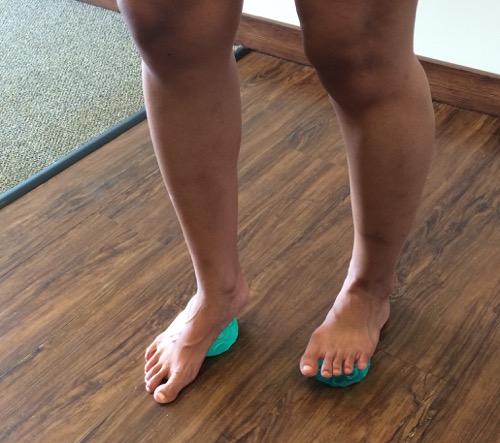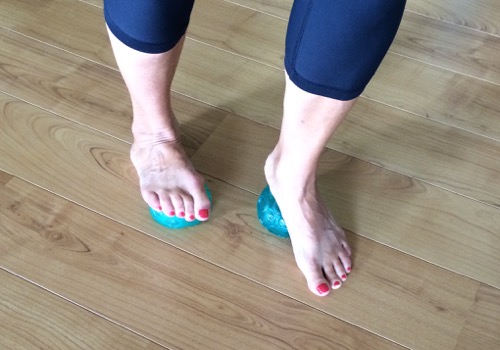by Jan Dunn, MS
We recently posted an article showing you the first part of a terrific foot warm-up, from the Franklin Method, using small balls—and if you’ve been trying it, you may have learned that it warms up more than just the feet!
I promised you the 2nd half, for both feet, and here it is. I suggest you read this full article first, as opposed to following along as I describe it. This is very much a balance / core stability challenge, and I want to give you some cues along the way. So read first / do afterwards, incorporating the cues…
First do right foot / left foot individually, as shown in Part 1. Then –
Up And Over
Put both balls together, a couple inches apart. Brace your heels on the ground, and put your forefoot on the balls, with knees straight. You’ll notice a nice Achilles stretch as you take that position.

Roll up and over the balls, so that your toes are now braced on the floor, with your heels on the balls. Keep your knees straight as you do this.
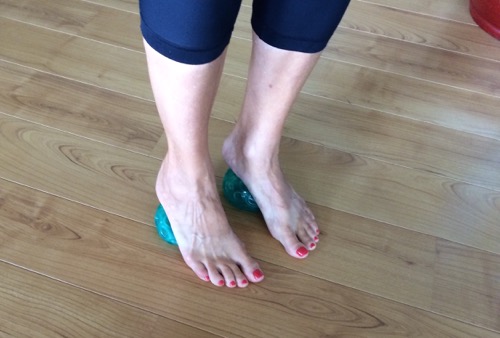
Practice rolling back and forth, with knees still straight, from toes to heels, keeping your body centered and aligned. Your feet are basically going from plantar flexion (pointing) to dorsi-flexion (ankle flexion), in anatomical terms.
Tips and cues:
-Keep your gaze straight ahead—looking down tightens the muscles in your cervical spine (neck) and will affect your balance.
-Use all the torso alignment cues / imagery that you have been taught – some of my favorite are:
-Lengthening through the spine, as though you have a beautiful colored vortex of energy spiraling up inside the body.
-Imagine a water fountain spouting up from the base of pelvis, all the way out through the top of your head.
-In good torso alignment, the sternum (breastbone) is in a direct vertical line over the pubic bone, which means ribs are directly in line with the pelvis—imagine a connection between these two points, linking your ribs & pelvis as you go forward and back over the balls. You may notice activation of your lower abdominals as you use that image—that is part of your “core control”, or “center” working.
-Think of “lifting images” at the bottom of the pelvis –inside the pelvic bowl…..such as:
a flying carpet lifting you up / an elevator going up /
a hot air balloon rising into the sky.
All of these images will help activate the pelvic floor muscles, which are also part of our “core” musculature, and work in concert with the lower abdominals and certain back muscles, to provide spinal / torso support.
At some point in your rolling forward and back, pause with your heels on the floor. Notice the good stretch in the Achilles. Now slightly bend your knees, still with the heels on the floor. Notice the difference in the stretch? That’s because you have two major muscles in your calf—one, the gastrocnemius, attaches above the knee. The other, the soleus, attaches below. Both of them come down to form the Achilles tendon. So to adequately stretch all portions of the calf / Achilles, you have to do both straight and bent knee stretches.
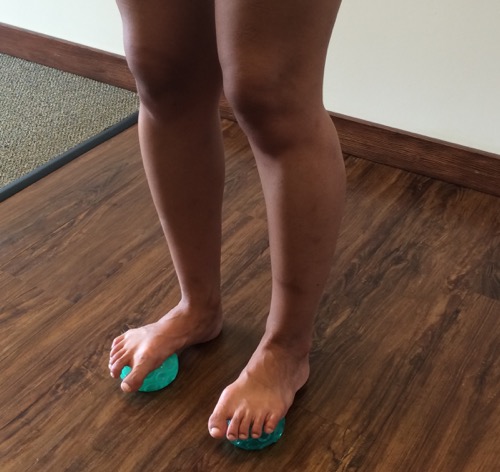
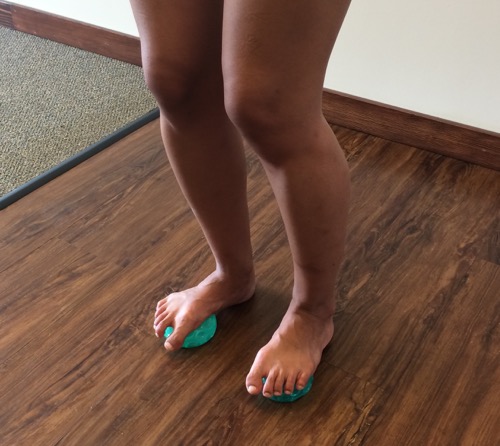
Transfer Weight
Now change the forward / back motion, so that one knee is bent, with toes braced on the floor, and the other is straight, with heel on the floor. Transfer your weight so that you’ve switched feet—the one that was bent is now straight, and the straight one is bent. You are essentially doing a dance prance, back and forth, on the balls.
As you do the prance, keep the images / cues going, to help your balance and control.
Balance Practice
Finally, at the end, you can practice balancing on the balls with no toes—no heels on the ground (just like you did with one foot, in Part I). Again, keep all your cues going as you try to maintain your balance.
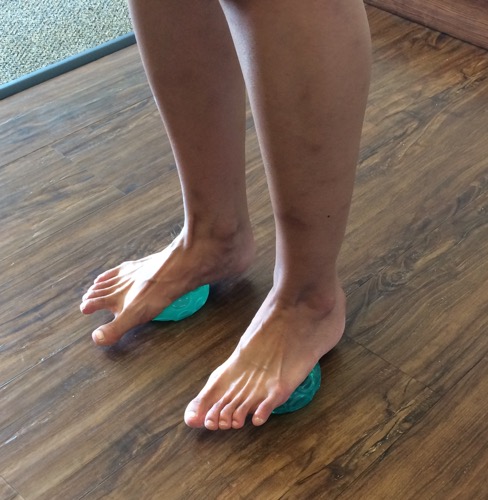
Other Versions
With A Partner
Don’t be surprised if you feel clumsy at this series at first, even if you are an advanced dancer! It’s difficult initially for most people, although dancers usually get it faster than most. When I teach it in a class setting, I always have dancers partner up, so that one person can do it, and the other can hold their hands at first (facing each other), as they get the feel of rolling on the balls / controlling the movements. But be forewarned! Don’t look at each other as you’re doing it, if with a partner—or you’ll probably burst out laughing, and it will completely throw you off. Look past your partner’s shoulder, not at their face or eyes.
Once the active person is getting the movement under control, the partner holding the hands can step back, and let them try it on their own.
Advanced Versions
When you get good at the plain balancing, you can add advanced versions, which are fun to play with, to challenge your stability. All of this is done without touching toes or heels on the ground, just balancing with the balls in the middle of the arch. You can:
-add arm work, like a port de bras, as you are balancing
-do plies
-do a spinal curl down and up (yes, it IS possible!)
In A Group
I have even done it in a group setting, with everyone in a circle, balancing on the balls while passing additional balls to the person next to them. You can probably be creative and think of other challenging ways to maintain control while balancing on both balls.
So that completes Part 2 of the Franklin Method Ball Foot Warm-Up. I hope you enjoy it! As I said, dancers usually love it, and it’s a terrific way to help things start to get warmed up at the beginning of a class or movement session.
Thank you to Sarah Carasco and Hannah Sachs for lending us their time (and feet!) for this post!

Editor Jan Dunn is a dance medicine specialist currently based on the island of Kauai, Hawaii, where she is owner of Pilates Plus Kauai Wellness Center and co-founder of Kauai Dance Medicine. She is also a Pilates rehabilitation specialist and Franklin Educator. A lifelong dancer / choreographer, she spent many years as university dance faculty, most recently as Adjunct Faculty, University of Colorado Dept. of Theatre and Dance. Her 28 year background in dance medicine includes 23 years with the International Association of Dance Medicine and Science (IADMS) – as Board member / President / Executive Director – founding Denver Dance Medicine Associates, and establishing two university Dance Wellness Programs
Jan served as organizer and Co-Chair, International Dance Medicine Conference, Taiwan 2004, and was founding chair of the National Dance Association’s (USA) Committee on Dance Science and Medicine, 1989-1993. She originated The Dance Medicine/Science Resource Guide; and was co-founder of the Journal of Dance Medicine & Science. She has taught dance medicine, Pilates, and Franklin workshops for medical / dance and academic institutions in the USA / Europe / Middle East / and Asia, authored numerous articles in the field, and presented at many national and international conferences.
Ms. Dunn writes about dance wellness for 4dancers and also brings in voices from the dance wellness/dance medicine field to share their expertise with readers.






